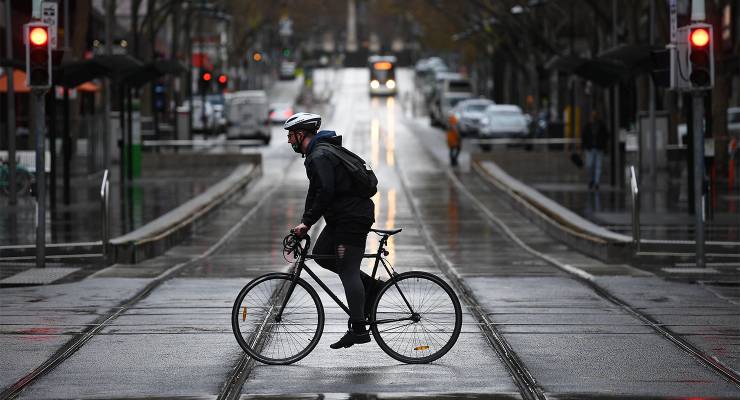
Early afternoon last Thursday, 22-year-old Angus Collins was killed while riding his bike down Footscray Road, hit by a cement mixer turning across his path at a poorly designed intersection. This tragedy — a life cut short, a family permanently scarred — was just one of three road deaths that day in Victoria, and one of 37 so far this year.
A serial killer murdering at a similar rate would induce mass panic. Instead, we’ve collectively decided that an ongoing stream of death, injury and grief is the price we’re willing to pay to keep our transport system moving. Even how we describe the deaths on our roads conjures images of mere annoyance: the “road toll” is more than a price — it’s a national health emergency.
The imperative for emergency services is to sweep the broken glass, wash off the blood and get (motorised) traffic moving again. When a food delivery rider was hit by an SUV outside my house recently, the attending paramedic focussed on dragging the bike off the road and waving cars through before attending to the visibly bleeding patient sitting in the gutter.
More than any other group, these riders spend hours enduring Australia’s dangerous roads, forced to deliver at night, in frequently hazardous conditions, often for sub-minimum wage and without Medicare coverage. Unsurprisingly, their death and injury rates are frequent, routine and underreported.
Investing in safety
Both outer-suburban roads and narrow inner-city streets are dominated by cars. Car lanes and parking dominate space — and all of the budget. Of all short journeys (fewer than two kilometres), 70% take place by car in Australian cities because everything is set up to make that the default option.
On average, most Australian states and territories currently dedicate only around 2% of transport budgets to active transport projects such as walking and cycling infrastructure (the UN recommends 20% at minimum). Most of the rest is spent on car and truck roading with a “one more lane will fix it” mindset.
The intersection where Angus Collins was killed was obscured by a pillar for the under-construction West Gate “Tunnel” (really a new freeway for trucks). In spite of warnings that the project would only increase congestion, the government went ahead anyway — it has since been plagued by massive delays and cost overruns.
Even public transport projects seem unable to be talked about in ways that don’t centre cars and trucks. Daniel Andrews’ signature Level Crossing Removal Project (or LXRP) is pitched as “you’ll spend less time waiting at the boom gates in your car”. Outcomes for nearby public transport, cycling and walking seem like an afterthought, both during and after.
In my local area, the upcoming Brunswick LXRP will shut down Melbourne’s major northern safe cycling route and train line for a year at least, forcing more bikes (and cars) into the congested Sydney Road, already a dangerous road to cycle (I’m a fairly experienced and confident cyclist, but I avoid Sydney Road entirely unless feeling particularly combative and zealous). Death and injury will be the inevitable result, but again, nobody (certainly nobody with any decision-making power) seems to care.
Rather, decision-makers appear to be working against making roads safer for cyclists. State Labor MP Lizzie Blandthorn, for example, has campaigned against proposals to remove parking to make way for bike lanes on Sydney Road, because of an ostensible threat to local retailers. This is despite widespread evidence that removing car parking is good for business, and the fact Sydney Road has plenty of off-street car parking. Local council, residents and many businesses have backed the Sydney Road renewal plan, but it remains blocked by the Department of Transport.
Car dominance
Without safe streets, car dominance becomes a self-fulfilling prophecy and self-reinforcing phenomenon. Nobody wants to walk and cycle on dangerous, polluted, car-clogged roads, so they jump into cars themselves. We feel the need to buy ever-larger, heavier vehicles in order to feel safe around the larger vehicles everybody else is buying.
Dysfunctional economics and planning then amplifies the problem. Permit parking turns public land into private car parking, deeply subsidised by its absurdly below-market cost (typically about $50 a year in inner-city suburbs). Good luck renting land for any other purpose for anywhere near this price in any of our capital cities. (Why can I store my car permanently on the street but not my bike? Or portacabin for that matter?)
Electric “vehicle” policies and subsidies are for cars only. Large, unnecessary, pedestrian-killing utes are incentivised through the tax system, while electric bikes, almost certainly the most environmentally friendly vehicle ever created, get nothing. And while electric cars produce less CO2, they emit more particulate pollution through tyre wear because of their additional weight. Both the carbon emissions and the economics of an EV, with a high up-front price and low per-km cost, encourage owners to drive further and more frequently.
Inner-city NIMBYs and change-fearing councils then consistently reject increased housing density. The result is sprawling, poorly serviced new suburbs on the outskirts of cities that force people into car-dependent lifestyles, where it can take 20 minutes in a traffic jam just to leave your own housing estate. Pollution is rife, and active, healthy lifestyles are not difficult — they’re impossible. Instead, stress, social isolation and obesity thrive.
A path forward
The solutions to these problems aren’t complex, or difficult, or expensive. Streets that don’t kill are easy: slower speed limits, separated bike paths, fewer car parks, more pedestrian crossings, and intersection designs replicated not just from the cycling paradises of Copenhagen or Amsterdam but now even large cities like New York, Paris or London. As a bonus: half-decent public transport.
Australia implements none of these. Legislators instead focus on victim-blaming measures like cycle helmet laws, despite evidence showing they discourage bicycle use, which is far more dangerous to health than sometimes not wearing a helmet. In the UK, for instance (where helmets are not compulsory), the British Medical Journal showed back in 2017 that the mortality rate of cyclists is 40% lower than those who drive to work.
It’s possible to start solving all of this tomorrow, if we want to. All it takes is treating the lives of people on foot and on bikes as equal in value to those in larger vehicles. Otherwise, people will continue to die, while God forbid some motorists are inconvenienced.
Should the government be doing more to protect cyclists? Let us know by writing to letters@crikey.com.au. Please include your full name to be considered for publication. We reserve the right to edit for length and clarity.








There’s an article on today’s ABC site covering the same story (Death of 22-year-old cyclist in West Melbourne prompts calls for left turn ban at intersection – ABC News).
I think a large part of the problem is encapsulated in the links at the bottom of the report:
More on:
Cycling is classified as ‘lifestyle and leisure’. Not as a serious means of commuting. Just something to amuse the latte sippers and, hey, who’ll miss a few of them? In which case, who gives a rats about safety or anything like that? Cyclists should just shut up and be grateful for anything they get.
I’ve ridden that bicycle path. It is the main feed route into the city for cyclists coming in from the West, and I can promise you that for pretty much all of the riders coming that use it, ‘leisure’ is the last thing on their minds. They are simply trying to get to work as safely and with as little hassle as possible. At the same time, they represent one less car competing for space on the roads, or one less passenger crushed into overpacked peak hour public transport. So car drivers and public transport users get something from bicycle riders as well.
It’s a bloody horrible route to ride, by the way. Crossing paths at least half a dozen times with the heaviest concentration of heavy vehicles in Melbourne, which before the current construction activity led to speed limit decrease, moved at eighty kilometres an hour. What genius thought to locate the main cycling route into town along that road in the first place?
And don’t ask me about trying to ride through Footscray once the bike path ends.
‘Cycling is classified as ‘lifestyle and leisure’’. Avoidance of taking cycling seriously also reflects the urban design of Australian cities and town giving priority to (IC) vehicles influenced by the fossil fueled Chicago Plan (?), aggressive &/or lax attitudes of many drivers and even dog whistling cyclists in media, to boost car drivers’ egos?
Goodness yes. Australia is so vastly behind the eight ball on this. Cycling infrastructure is cheap, and every kilometre cycled saves society money.
How much will be spent by CASA investigating the chopper crash on the gold coast? 4 cyclists (or pedestrians die), how much spent making things safer?
Transport usage is driven by supply. Whilst we keep supplying more roads for cars there will be more cars. But if we built more active transport infrastructure there would be more active transport – a win for all road users and our health system.
Great to see the author call out how we all subsidise people who park their private cars on public roads.
Good article.
That young cyclist had a green light. The truck had a green light. How could that be allowed to happen??? It’s totally unacceptable to design such a dangerous intersection for cyclists to be hit by left turning trucks when they have a green light. I’m speechless. Makes me rethink commuting on my bike on Footscray road. I’d rather risk the train and COVID